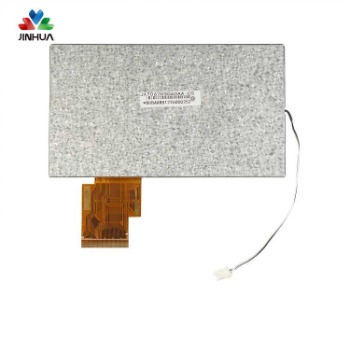1. Einführung in TFT
TFT ist die Abkürzung der englischen Initialen für Thin Film Transistor. Es hat die doppelten Eigenschaften „aktiv (schalten, verstärken)“ eines Transistors und „dünn“ eines „Dünnfilms“. In Kombination mit einem Flachbildschirm (z. B. LCD, OLED usw.) bildet es den heutigen Flachbildfernseher (TFT-LCD, TFT-OLED). TFT ist eine der wichtigsten Kernkomponenten.
Normalerweise ist das aktive Material von TFT ein Siliziumfilm. Entsprechend der unterschiedlichen Struktur des Siliziumfilms werden Transistoren in amorphes Silizium-TFT (a-Si-TFT), polykristallines Silizium (p-Si-TFT) und einkristallines Silizium-MOSFET (c-Si-MOSFET) unterteilt. Darüber hinaus werden TFTs aus organischen Materialien als organische TFTs (oder OTFTs) bezeichnet.
Seit ihrer Erfindung in den 1960er Jahren wurden Dünnschichttransistoren in großem Umfang gefördert und eingesetzt, und ihre Entwicklungsgeschwindigkeit ist unvorstellbar. Vom amorphen Silizium-TFT zum polykristallinen Silizium-TFT, vom polykristallinen Hochtemperatur-Silizium-TFT zum polykristallinen Niedertemperatur-Silizium-TFT wird die Technologie immer ausgereifter, und das Anwendungsobjekt hat sich auch vom reinen Ansteuern von LCD zum Ansteuern von LCD, OLED entwickelt. und sogar elektronisches Papier. Da sich das Niveau der Halbleitertechnologie weiter verbessert, nimmt die Pixelgröße immer weiter ab und die Auflösung des Bildschirms wird immer höher.
TFT-adressierte LCD-Displays sind mit ihrer großen Kapazität, hochauflösenden und vollfarbigen Videoanzeigen zur vorherrschenden Technologie für LCDs und sogar Flachbildschirme geworden, und verwandte High-Tech-Industrien sind ebenfalls zur aktuellen Hauptinvestitionsrichtung geworden. Die TFT-Herstellungstechnologie spielt bei TFT-adressierten Flüssigkristallanzeigen eine Schlüsselrolle und ihre Forschung und Entwicklung stand schon immer im Mittelpunkt der Forschung.
2. Fahrweise anzeigen
Sowohl LCD- als auch OLED-Displays werden in zwei Kategorien unterteilt: aktive Anzeige und passive Anzeige. Für die LCD-Anzeige wird sie in passive (passive) Laufwerksanzeige-LCDs unterteilt, z. B.: Farb-STN-LCD-Anzeige, STN-LCD, TN-LCD usw.; Aktives (aktives) Laufwerksanzeige-LCD, wie zum Beispiel: TFT-LCD. Bei der OLED-Anzeige wird in passive (passive) Antriebsanzeige OLED (PMOLED) und aktive (aktive) Antriebsanzeige OLED (AMOLED) unterteilt.
Passive (passive) Antriebsanzeigen OLED oder LCD können in der Regel nur weniger als 200 Zeilen gleichzeitig darstellen. Um mehr Zeilen anzuzeigen und eine hohe Auflösung zu erreichen, wird daher eine aktive (aktive) Laufwerksanzeigemethode verwendet, d. TFT-LCD, AMOLED. Aktive (aktive) Laufwerksanzeigemethoden umfassen die TFT-Produktionstechnologie.
3. TFT-Filmtechnologie
1. Amorpher Siliziumfilm. Die Dünnschichttransistortechnologie aus amorphem Silizium wurde in den 1970er Jahren vorgeschlagen. Nach fast 30 Jahren unermüdlicher Bemühungen von Wissenschaftlern aus verschiedenen Ländern sind nun alle Produktionslinien für Flüssigkristallanzeigen (LCD) der siebten Generation automatisiert und die industrielle Produktionstechnologie ist ziemlich ausgereift. Es hat sich heute weltweit zum Mainstream-Produkt von LCD-Monitoren entwickelt, und das Ziel der zukünftigen Entwicklung ist eine größere Bildschirmgröße und niedrigere Produktionskosten. Der Vorteil der amorphen Silizium-TFT-Technologie besteht darin, dass der Herstellungsprozess ausgereift, relativ einfach und eine hohe Ausbeute ist, wodurch sie für die großflächige Produktion geeignet ist. Der Nachteil besteht darin, dass TFT nur über N-Typ-Geräte verfügt und seine Mobilität nur 0,5–1,0 cm2/Vs beträgt. Daher ist es schwierig, hochleistungsfähige, vollständig integrierte, ultradünne und kompakte Anzeigemodule mithilfe des amorphen Silizium-TFT-Prozesses herzustellen. Die amorphe Silizium-TFT-Technologie kann nicht für hochauflösende aktivgesteuerte OLED-Displays verwendet werden.
2. Polykristalliner Siliziumfilm (Poly-Si). Polykristalline Silizium-Dünnschichtprozesse werden hauptsächlich in zwei Kategorien unterteilt:
(1) Hochtemperaturprozess bezieht sich auf eine Temperatur von mehr als 900 °C während des gesamten Verarbeitungsprozesses. Beim Hochtemperaturprozess kann nur teures Quarz als Substrat verwendet werden und die TFT-Leistung ist gut. Das Hochtemperaturverfahren eignet sich nur für kleine und mittelgroße Bildschirme bzw. Projektionswandserien.
(2) Niedertemperaturprozess, die Temperatur während des gesamten Verarbeitungsprozesses liegt unter 600 °C. Mit Niedertemperaturprozessen lassen sich größere Displays auf preiswerten Glassubstraten herstellen. Niedertemperatur-Polysilizium-TFTs (LTPS) werden aufgrund ihres geringen Stromverbrauchs, ihres geringen Gewichts, ihrer Dünnheit, ihres großen Stromverbrauchs und ihrer Systemintegration häufig in TFTs mit aktiver (aktiver) Antriebsanzeige, LCDs und AMOLEDs, verwendet. Der Schlüssel zum polykristallinen Silizium-TFT-Prozess besteht darin, hochwertige polykristalline Silizium-Dünnfilme großflächig und kostengünstig herzustellen. Zu den Methoden zur Herstellung von Polysiliziummaterialien gehören derzeit Rapid Annealing (RTA), Excimer-Laser-Kristallisation (ELC), Festphasenkristallisation (SPC), kontinuierliche laterale Kristallisation (SLS) und metallinduzierte Niedertemperatur-Polysilizium-Technologie (MIC).
Die Niedertemperatur-Polysilizium-LTPS-TFT-Technologie kann die Probleme vollständig lösen, die die amorphe Silizium-TFT-Technologie nicht lösen kann. Insbesondere nach dem Jahr 2000 investierten japanische, koreanische und taiwanesische Hersteller aufgrund der Überkapazität von a-Si-TFT aktiv in LTPS-TFT, was LTPS-TFT in den nächsten Jahren mehr Entwicklungsmöglichkeiten eröffnete. Insbesondere mit dem jüngsten rasanten Wachstum des Marktes für kleine und mittlere Panels beginnt für die Entwicklung von Polysilizium-TFTs eine goldene Ära. LTPS-TFT gilt seit langem als notwendige Technologie für die nächste LCD-Generation.
3. Organisches Dünnschicht-TFT. Es ist offensichtlich, dass das Aufkommen organischer TFTs eine starke Konkurrenz für bestehende amorphe Silizium-TFTs darstellen wird. Es wird die Kerntechnologie einer neuen Generation flexibler Displays sein. Mit flexibler Display-Technologie hergestellte Displays können wie eine Leinwand gerollt werden und könnten wie LCDs zu einem wichtigen Akteur in der Displaywelt der Zukunft werden.
Durch die Verwendung organischer Materialien verfügt es über die Eigenschaften eines flexiblen Displays, ist also nicht nur stoßfest, sondern auch leicht und klein in der Größe. Nicht nur das Erscheinungsbild des Displays wurde verändert, sondern auch die Anwendungsumgebung wurde stark erweitert und diversifiziert. Durch den Druck von Displays auf Kunststofffolien im Tape-and-Reel-Verfahren, das dem Zeitungsdruckverfahren ähnelt, können die Produktionskosten erheblich gesenkt werden.
OTFT-Forschung wird seit fast 20 Jahren international betrieben, aber die Frage, wie man Hochleistungsgeräte entwirft und verarbeitet, wie man die Verarbeitungskosten senkt und wie man organische Halbleitermaterialien mit hoher Mobilität und Umweltstabilität synthetisiert, war schon immer ein Forschungs- und technischer Engpass . Derzeit ist noch kein substanzieller Durchbruch erzielt worden. Insgesamt steckt die internationale Forschung im Bereich der flexiblen Elektronik noch in den Kinderschuhen und es besteht großes Potenzial für technologische Durchbrüche und Patentanmeldungen.
4. Anwendungen von TFT-Displays (hauptsächlich die folgenden vier Kategorien)
1. Tragbares Display: videofähiges Mobiltelefon, videofähiger PDA, videofähiges E-Book usw.;
2. Fahrzeugmontierte Anzeige: GPS, Anzeige für sicheres Fahren, Multimedia-Anzeige usw.;
3. Computeranzeige: Laptop, Monitor usw.;
4. Haushaltsgeräte und Bürodisplays: Fernseher, Internetterminals, elektronische Zeitungen usw.
Kurz gesagt, die TFT-Technologie nimmt eine Kernposition in der Flachbildschirmindustrie ein. Es ist kapitalintensiv, talentintensiv und technologieintensiv. Der Panel-Ausgabewert ist hoch und der Branchenagglomerationseffekt ist offensichtlich.






 English
English Deutsch
Deutsch русский
русский español
español العربية
العربية



 IPv6 NETZWERK UNTERSTÜTZT
IPv6 NETZWERK UNTERSTÜTZT
